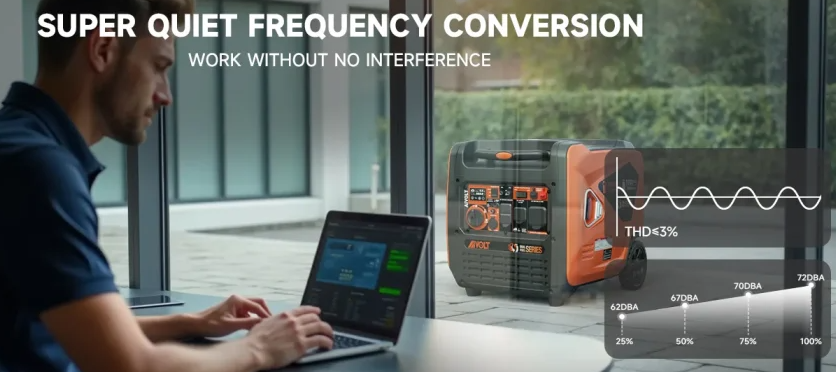If you’ve used a traditional generator, you know its loud, constant hum can disrupt campsites, upset neighbors, or ruin outdoor gatherings. Inverter generators—like AIVOLT’s super-quiet models—solve this problem, often operating at just 50–60 decibels (equivalent to a normal conversation). But why are they so much quieter? The answer lies in three core design choices and engineering tweaks that reduce noise at its source.
1. Variable Engine Speed: No More Constant High RPM
The biggest reason inverter generators stay quiet is their variable engine speed—a feature traditional generators lack.
Traditional generators run at a fixed speed (usually 3600 RPM) 24/7, even when powering small devices like a phone charger. This constant high speed is needed to maintain a steady 60Hz electrical frequency, but it also creates a loud, unrelenting noise.
Inverter generators, by contrast, adjust their engine speed to match the power load. For example:
- When charging a phone with AIVOLT’s 1600W ultra-quiet model, the engine slows to a low idle (around 1500–2000 RPM), producing minimal noise.
- When powering a small fridge or camping microwave, the engine speeds up only as much as needed—never more than necessary.
This “on-demand” speed control cuts noise drastically. At low loads (the most common use case for portable generators), the engine runs so softly you might forget it’s on—perfect for nighttime camping or residential power outages.
2. Advanced Muffler & Enclosure Design: Blocking Noise at the Exit
Even with variable speed, engines still make noise—and inverter generators add extra layers to muffle it, starting with improved mufflers and sound-dampening enclosures.
Mufflers Built for Quiet
Traditional generators use basic mufflers that only reduce exhaust noise slightly. Inverter generators (like AIVOLT’s 8000W dual-fuel model) have larger, more complex mufflers with extra chambers. These chambers slow down exhaust gases and bounce sound waves off each other, canceling out noise before it escapes. Some high-end models even add baffles or foam linings inside the muffler for extra quiet.
Sound-Dampening Enclosures
Most inverter generators also have enclosed bodies lined with sound-absorbing materials (like foam or rubber). AIVOLT’s 1200W–1800W small models, for example, use compact enclosures with thick, noise-blocking panels that trap engine and vibration sounds inside. The enclosures are also shaped to minimize air turbulence—another small but impactful source of noise—while still letting enough air flow to keep the engine cool.
Traditional generators, by comparison, often have open or thin metal frames that let noise escape freely. The difference is stark: an open-frame traditional generator might hit 80dB, while an enclosed inverter generator with the same power stays under 65dB.
3. Reduced Vibration: Less Rattling, Less Noise
Vibration is a hidden noise culprit—even a quiet engine can sound loud if it shakes against its frame. Inverter generators fix this with vibration-dampening components.
Engine Mounts That Absorb Shak
Inverter generators use soft, rubberized engine mounts instead of the hard metal mounts in traditional models. These mounts act like shock absorbers, soaking up the engine’s vibrations so they don’t transfer to the generator’s frame or the ground. For example, AIVOLT’s 3300W home emergency model has four reinforced rubber mounts that keep the engine steady, even when it speeds up to power an AC unit.
Balanced Internal Parts
Inverter generators also use more precisely balanced internal components (like alternators and fan blades). Traditional generators often have heavier, less balanced parts that create extra vibration as they spin. The smoother, more balanced parts in inverter generators reduce both vibration and the rattling noise that comes with it—making them feel (and sound) more stable.
Why This Quiet Advantage Matters for You
The quietness of inverter generators isn’t just a “nice-to-have”—it expands where and when you can use them:
- Campsites: A 55dB inverter generator won’t disturb your tent neighbors or wildlife, unlike a loud traditional model that might get you asked to turn it off.
- Residential Areas: During power outages, AIVOLT’s 8000W dual-fuel ultra-quiet model can run a fridge and lights without waking the neighborhood or drawing complaints.
- Outdoor Events: Whether you’re powering a speaker for a backyard BBQ or a projector for a movie night, the generator’s hum will blend into background noise instead of dominating it.
In short, inverter generators are quiet because engineers designed them to target noise at every stage—from how fast the engine runs to how well they trap sound and absorb vibration. For anyone who needs power without the racket, this design makes them far more useful than traditional generators.
If you’re looking for a quiet inverter generator, AIVOLT’s range (from the 1600W $299 model to the 11250W dual-fuel unit) prioritizes all these noise-reducing features—proving you don’t have to sacrifice power for peace and quiet.

